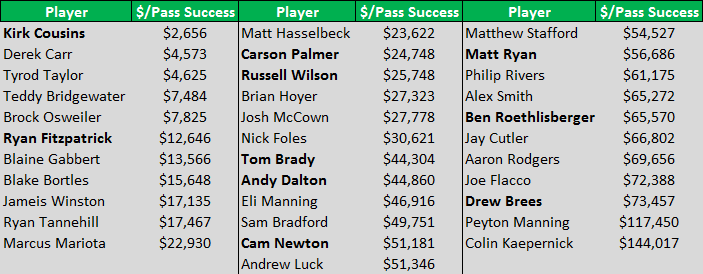The NFL's Most and Least Cost-Effective Quarterbacks in 2015

Spending big money on a good quarterback is about as big of a no-brainer as there is in the NFL.
Spending a decent amount on even an average quarterback tends to be defensible in some ways. (Would you rather overpay for Matthew Stafford or try to rely on Nick Foles?)
Heck, that's why Andrew Luck -- who hasn't been super elite in the NFL based on advanced metrics -- is expected to receive a "shocking" contract when his rookie contract ends.
When you have a shot at a franchise passer, sometimes you take it. Then again, with Kirk Cousins, Washington is apprehensive to overpay.
But based on his 2015 performance, he certainly deserves a raise. Even if Washington isn't the team to give it to him.
2015's Most Cost-Effective Quarterbacks
Young quarterbacks who haven't signed a monster contract but who flash their upside will always appear underpaid, but when you look at a player's salary cap hit (per Spotrac) and his on-field performance (based on our Net Expected Points metric), we can get a look at just how much of a bargain these players were.
Net Expected Points (NEP, for short) indicates how far above or below expectation level a player performs. A 10-yard pass will look fine enough in the box score and at the end of the year, but what if it came on 3rd-and-25? What about 3rd-and-5 in the red zone? Those are very different plays, and NEP accounts for that discrepancy by indicating how a player impacts his team's chance of scoring.
For some context, Carson Palmer led all quarterbacks in Total NEP, generating 190.20 points above expectation. Only three other passers topped 150. In total, 10 topped 100. With a salary cap hit of $7,375,000, which ranked 18th among the 72 passers to attempt a drop back this year, that's a value.
Cousins posted a Total Net Expected Points score of 146.02, sixth-best in the NFL, at a salary cap hit of $778,172, 53rd among the group.
How good did that look in terms of dollar per Net Expected Point among the 32 passers who managed a positive Total NEP and attempted at least 250 drop backs last year? (Top-10 passers in terms of Total NEP are in bold.)
Talk about a bargain.
For what it's worth, Tyrod Taylor just missed the cut as a top-10 guy, ranking 11th. Still, the distance between those two and Ryan Fitzpatrick at third is quit cavernous. But at least the Jets didn't spend $17 million to get fewer than a field goal above expectation from the duo of Blaine Gabbert and Colin Kaepernick.
Sure those marks look bad, but consider that not every player posted a positive NEP total (cough, cough Peyton Manning), so calculating things gets a bit tricky.
We can, though, look at the price per drop back that led to positive NEP gains. Was Cousins still at the top? Was Kaepernick any less bad?
Yep. No.
The cheaper passers by this measure skewed younger, which makes sense, but just check out those numbers for guys near the bottom, such as Kaepernick and Manning.
Sure, they didn't play the full season and got paid a hefty salary intended for a full year, but that's what they provided their team -- which was the point of the study.
Perhaps the biggest takeaway is that plenty of top-10 passers by Net Expected Points were overpaid in terms of cost for a successful NFL play, but that price is sometimes worth it so that you don't have the type of situation that teams such as the 49ers are in.
Then again, Kaepernick sure looked better when he signed that six-year deal worth more than $110 million.


















